Drilling concrete is a common task in construction, but it poses serious risks due to respirable crystalline silica (RCS). Prolonged exposure to silica dust can lead to severe diseases like silicosis, lung cancer, and COPD. Selecting the correct mask, testing its fit, and adhering to the latest regulations are essential for ensuring safety.
This guide combines insights from the HSE, regulatory requirements, and practical tips to help you select the right mask based on task duration, dust levels, and fit testing requirements.
What Does “Face-Fit and Dust Mask Required” Mean?
1. The Fit Must Be Verified
A dust mask only works if it seals properly to the face. Face-fit testing is required under COSHH Regulations 2002 and BS EN 529:2005 (Clause 9.3.1) to ensure that the mask is effective and suitable for the individual.
2. Protection Against Silica Dust
Concrete dust, especially RCS, can bypass poorly fitted masks and cause long-term harm. Selecting a mask certified to the correct standards ensures adequate protection.
Facial Hair and Mask Fit: A Critical Concern
Facial hair can interfere with the mask’s ability to create a proper seal, significantly reducing its effectiveness.
Why is Facial Hair a Problem?
- Seal Breaks: Even stubble can prevent the mask from sealing tightly to the face, allowing harmful particles to bypass the filter.
- Regulatory Requirement: For face-fit testing to pass, the wearer must be clean-shaven in the area where the mask seals.
What the HSE Recommends
- Clean-Shaven Policy: Workers required to wear tight-fitting masks must shave any facial hair that could compromise the seal.
- Alternatives: For workers unable to shave, consider powered air-purifying respirators (PAPRs) or other loose-fitting respirators that do not require a tight face seal.
The Rule of Thumb: Duration-Based Mask Selection
The HSE recommends selecting masks based on task duration and risk level:
Minimal-Duty Tasks (Under 30 Minutes)
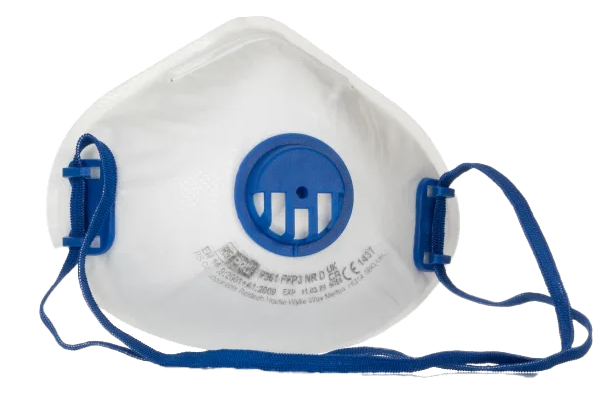
- Protection: A disposable FFP3 mask certified under BS EN 149:2001+A1:2009.
- Fit Testing: Requires a Qualitative Fit Test (QLFT), which uses taste or smell to verify the fit.
Medium-Duty Tasks (30 Minutes to 1 Hour)
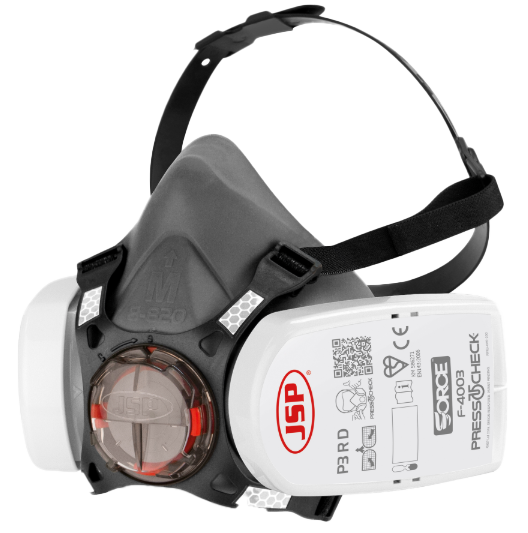
- Protection: A half-face mask with P3 filters certified under BS EN 140 and BS EN 143.
- Fit Testing: Requires a QLFT for verification.
High-Duty Tasks (Over 1 Hour)
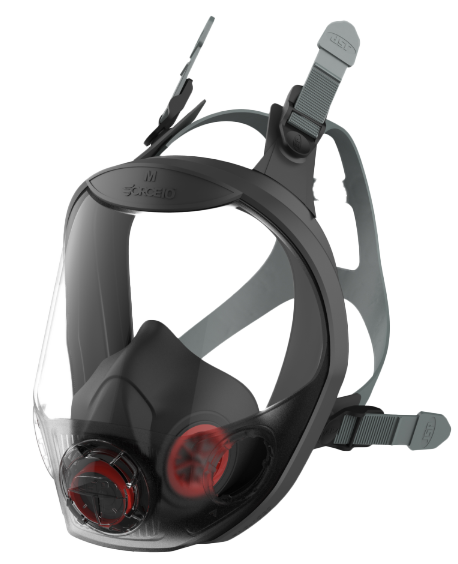
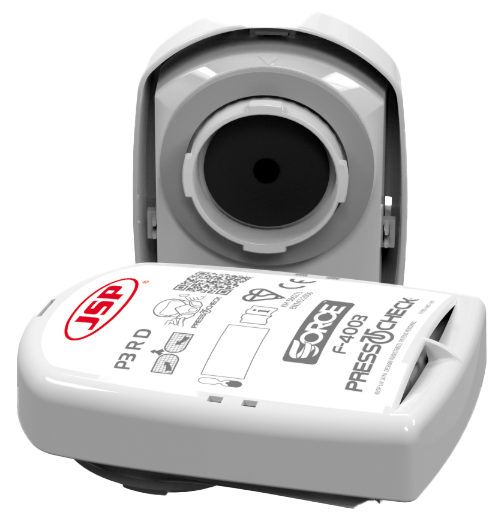
- Protection: A full-face respirator with P3 filters certified under BS EN 136 and BS EN 143.
- Fit Testing: Requires a Quantitative Fit Test (QNFT), which uses precise machinery to ensure an airtight seal.
Understanding Fit Testing: QLFT vs. QNFT
Qualitative Fit Testing (QLFT)
- Purpose: Used for disposable and half-face masks.
- Method: The wearer’s sense of taste or smell is used to detect leaks in the mask.
- Test Agent: Common agents include Bitrex (bitter-tasting) or Saccharin (sweet-tasting).
- Frequency:
- Performed initially for each employee using a specific brand and model of mask.
- Retesting is required every two years or if the mask type or the wearer’s face shape changes.
Quantitative Fit Testing (QNFT)
- Purpose: Used for full-face respirators and longer, high-risk tasks.
- Method: A machine measures air leakage to calculate a numerical fit factor.
- Advantages: Highly accurate but more time-consuming and expensive.
- Frequency: Retesting is required every two years or after significant changes.
Fit Testing: Specific to Each Brand and Model of Mask
Fit testing is not a one-size-fits-all process. It must be conducted for each employee using a specific brand and model of mask. This requirement applies to all tight-fitting masks, whether disposable, half-face, or full-face respirators.
Why is Fit Testing Brand- and Model-Specific?
- Different Designs: Masks vary in shape, size, and materials depending on the manufacturer, and these differences can affect how well the mask seals to an individual’s face.
- Consistency Matters: A fit test confirms that the chosen mask provides an effective seal for the wearer. If a different brand or model is used, the fit must be retested to ensure continued protection.
- Regulatory Requirement: Fit testing is required under COSHH Regulations 2002 and BS EN 529:2005, ensuring that the selected mask is suitable for the task and the individual.
Points for Employers and Employees
- Always use the same brand and model of mask that was successfully fit-tested.
- If switching to a new mask type, even from the same manufacturer, a new fit test is mandatory.
- Regular retesting is required every two years or sooner if the wearer’s facial structure changes or if there are significant updates to the mask design.
This ensures that workers are always protected and compliant with health and safety regulations.
Standards and Compliance for Masks
Masks must meet specific BS EN standards to ensure safety:
- BS EN 149: For disposable FFP masks (e.g., FFP3).
- BS EN 140: For half-face respirators.
- BS EN 136: For full-face respirators.
- BS EN 143: For particulate filters (P3 filters).
- BS EN 14387: For combined gas and particle filters, where additional hazards exist.
How to Determine the Correct Protection Level
Key Factors to Assess
- Duration of Exposure: Is the task under 30 minutes, up to 1 hour, or longer?
- Material Composition: Does the material contain high levels of silica?
- Ventilation: Is the work in an open space or a confined area?
Practical Use Cases
Minimal-Duty Tasks (Under 30 Minutes)
- Example: Drilling a few holes in concrete outdoors.
- Mask: Disposable FFP3 mask.
- Fit Test: QLFT.
Medium-Duty Tasks (30 Minutes to 1 Hour)
- Example: Drilling multiple blocks of concrete in a semi-confined space.
- Mask: Half-face respirator with P3 filters.
- Fit Test: QLFT preferred, QNFT optional for added precision.
High-Duty Tasks (Over 1 Hour)
- Example: Prolonged drilling or grinding of silica-rich materials in confined spaces.
- Mask: Full-face respirator with P3 filters.
- Fit Test: QNFT is mandatory.
Legal Compliance
Adhering to regulations ensures both safety and compliance:
- COSHH Regulations 2002: Control hazardous substance exposure.
- BS EN 529:2005: Provides guidance on selecting and maintaining respiratory protective equipment.
- PPE at Work Regulations 1992: Mandates face-fit testing for all tight-fitting masks.
- Construction (Design and Management) Regulations 2015 (CDM): Requires risk assessments for silica dust hazards.
Why Retesting Every Two Years is Critical
Even if a mask initially passes a fit test, it must be retested regularly to account for:
- Facial Changes: Weight fluctuations, dental work, or facial injuries can affect the fit.
- Mask Wear and Tear: Over time, masks and filters may degrade, reducing effectiveness.
- Facial Hair: If an employee grows facial hair after being fit-tested, the test result is invalid, and they must either shave or use an alternative respirator.
Changing of filters.
Let us take the supplier JSP Safety, below is a response and sheet having queried how often these need changing. To quote tech support “Basically, when doing the Press To Check, the mask will collapse onto the face. When this happens and you are not performing the PTC then that is time to change the filter, or 28 days from removal of packaging”.
Every supplier is different so ask their technical. And remember that the face fit is only valid for the exact mask you have chosen for your task. Meaning make sure you pick the most appropriate mask for your industry and task. There is no good getting a disposable mask fitting if your work requires a half or full face mask for a larger proportion of your tasks.
Always consult a specialist. And look up the procedure for changing and ascertaining the replacement cycle.
And again in image format in case you do not have the ability to view a pdf.
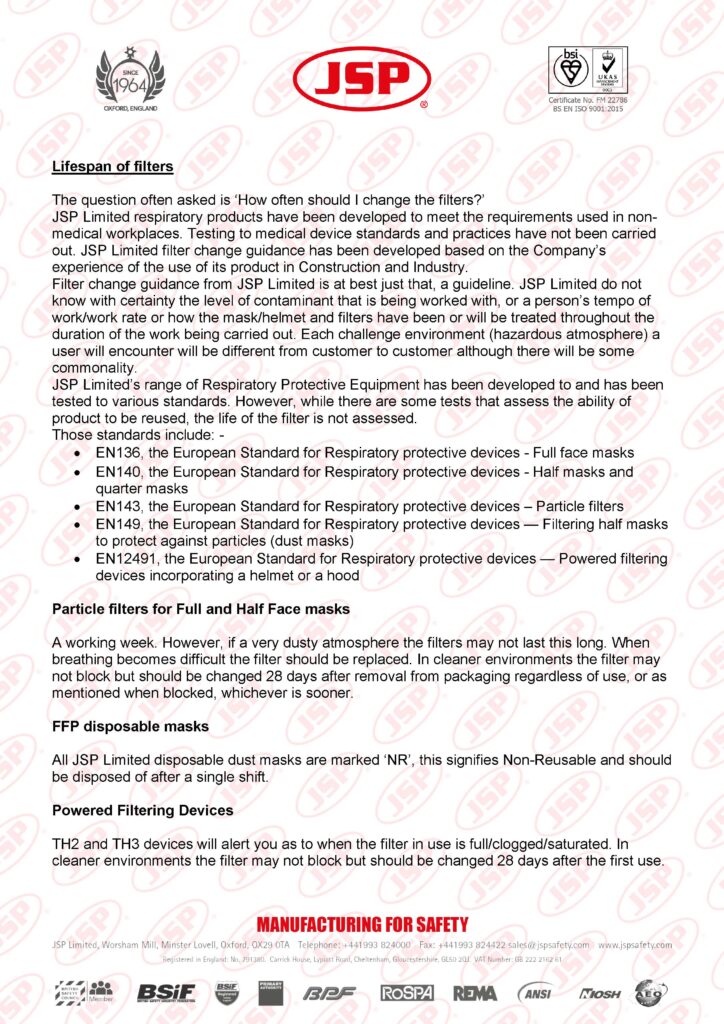
Rule Of Thumb Mask Use Table- Re Iteration
| Task Duration | Mask Type | Fit Test Required | Standards |
|---|---|---|---|
| Under 30 Minutes | FFP3 Disposable Mask | QLFT | BS EN 149:2001+A1:2009 |
| 30 Minutes to 1 Hour | Half-Face Mask + P3 Filters | QLFT | BS EN 140 and BS EN 143 |
| Over 1 Hour | Full-Face Mask + P3 Filters | QNFT | BS EN 136 and BS EN 143 |
Protect Yourself and Your Team
By selecting the appropriate mask, considering facial hair policies, and ensuring proper fit testing—whether QLFT for short tasks or QNFT for longer, high-risk tasks—you can ensure compliance and protect workers from silica dust.
Disclaimer:
The information provided on this site is for general informational purposes only and may not reflect the most current regulations or standards. Legislation, industry guidelines, and best practices can change over time, and it is the user’s responsibility to research and ensure compliance with the latest requirements for their specific situation. Always consult a qualified professional for advice tailored to your project or application.
